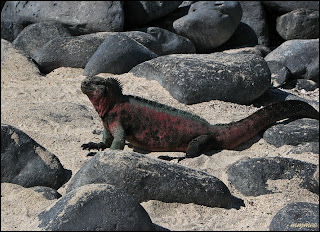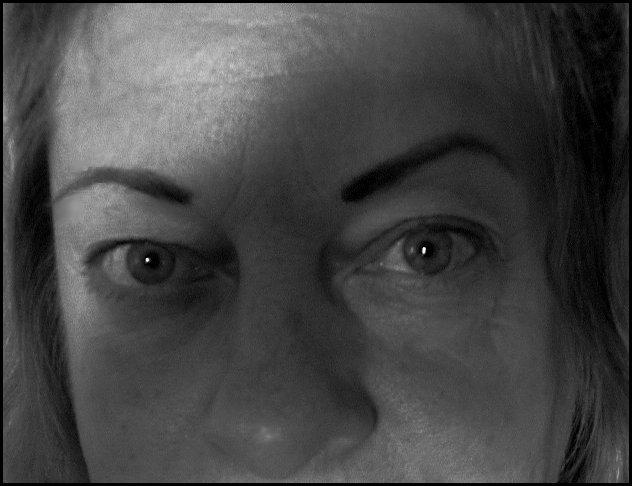Sunrise of March 9th
This might be Kicker Rock, but I am not sure.
One of the zodiacs behind the ship.
The ship's flag
The promised photo of Valerie and Harvey from the previous day
Sally Light Footed Crab, also from the day before.
A brown pelican from the previous day
Celebrity Xpedition: Tuesday, March 9, 2010
Morning activities:
Floreana Island is the sixth largest island in the archipelago and one of the four islands that Charles Darwin visited, aboard the HMS Beagle. Darwin was not impressed at the time by the Viceroy of Galapagos residing here in Floreana. The Viceroy claimed that he could look at a tortoise and derive its island of origina from the shape of its carapace; later this observance proved useful in Darwin's thought process and writings. In 1832 Ecuador annexed the Islands and established the first human settlement here. It soon turned into a penal colony as many political and other prisoners were sent here. This island was the first capital of the Galapagos during the 19th Century.
8:00 am Long Walk - Cormorant Point - wet landing - 1 1/2 to 2 hours
10:30 am Advanced Snorkel Activity - Champion Island - Note: This activity is for experienced snorkelers only. Duration 1 1/2 hour
Did you know ? HMS Beagle
Displacement: 242 Tons, Length: 90.3 feet, Beam: 24.5 feet, Draught: 12.5 Feet Complement: 120 Crew
HMS Beagle was a Cherokee class 10-gun brig of the Royal Navy, named after the beagle, a breed of dog. She was launched on 11 May 1820 from the Woolwich Dockyard on the River Thames, at a cot of 7,803 pounds sterling. In July of that year she took part in a fleet review celebrating the coronation of King George IV of the United Kingdom in which she was the first ship to sail under the new London Bridge. After that there was no immediate need for Beagle so she was kept in reserve for five years and "lay in ordinary", moored afloat but without masts or gigging. She was then adapted as a survey barque and took part in three expeditions. On the second survey voyage the young naturalist Charles Darwin was on board, and his work would eventually make the Beagle one of the most famous ships in history.
Afternoon and Evening activities:
In the 1930's Floreana became a setting for intrigue and mystery. A German dentist and his mistress, a young family (the Wittmer family who still live on the island) and a self proclaimed Baroness with three men came to settle on the island. Shortly after the Baroness and her lovers arrived chaos began. They terrorized the other inhabitants while planning to build a luxury hotel. Eventually the Barroness, her two lovers and the dentist all turned up missing or dead. There has been much investigation searching for what really happened on Floreana, but there have never been any hard answers for this reason Floreana is referred to as the "Island of Mystery". The landing site in the afternoon was supposedly used by the baroness to spot ships that would come to visit these "eccentric" residents of Floreana.
2:15 Xpedition Lecture: "Geology of the Galapagos Islands"
3:30 - Short Walk - wet landing - Baroness Lookout - Zodiac ride for wildlife observation with a wet landing - duration 1 hr 45 mins.
7:30 - Briefing abut Wednesday's visits
&:15 - 9:30 Dinner
10:30 - Approximate arrival time to our anchorage at Baltra Beach. If conditions permit we will have an opportunity for animal observation from Deck 4 aft. Occasionally we find Sea Lions, pelicans and sharks close to our anchoring lights
- stargazing.
8:00 am - Long walk - Cormorant Point - Wet Landing
We will make a wet landing on a beach that has a large amount of Olivine crystals that were part of the volcanic history of the site. Continuing into the interior we find two plant species that are only found at this particular site, eventually arriving to a very large brackish pond. Flamingos, stilts, and white cheeked pintail ducks are commonly sited here due to the amount to food present in the pond. We continue on the trail, crossing an isthmus arriving to a fine white sand beach which has a high coralline content. At the coralline beach it is usually easy to spot small rays, turtles and sharks from the seaside area. Please be careful not to walk on the back duen area for this has sea turtle nests. Sandals with straps are sufficient for this hike of 2 kilometers. Also you may land without shoes if you wish. Please take your snorkel equipment as we have a chance to snorkel on the beach area. It is possible to find paper wasps on this island. Try to avoid the use of bright colored clothes that might attract them.
10:30 am Advanced snorkeling Activity - Champion Island
After a 25 minute zodiac ride we will arrive at Champion, a small satellite island of Floreana. This island is one of the very few that holds a Floreana mocking bird population. Floreana mocking birds were present on Floreana during Charles Darwin's visit in 1835, however, they promptly left the island when cats were introduced in the 1800 hundreds, and are only found on the satellite islands. This Island has rocky slopes going to depths of 100 ft (30 meters) We will enter the water fromthe Zodiac at a depth of 40 - 50 ft. eventually ending at a shallow bay where may sea lions can be found. Apart from the palyful sea lions we may encounter Spotted Eagle rays, small sharks, Pacific Barracuda and Pacific Green Turtles.
Note: This activity is for experienced snorkelers only.
3:30 pm Zodiac Ride, short walk - wet landing - Baroness Lookout
Light zodiac ride through a mangrove area possibly observing Pacific green turtles, spotted eagle and golden rays, great egrets and lava herons. The small islands that we navigate around are formed of 'pillow' lava. Lava flows that are produced underwater making an interesting formation We will proceed to make a wet landing at a beach which requires water shoes or sandals for the disembarkation. This area was used in the 1920's as a lookout for arriving ships. From the beach area we will climb a steep switchback trail that is approximately 300 ft (90 meters). Sandals or water shoes with thick rubber soles are sufficient for the short hike.
Photographic equipment suggestions: Wide angle and zoom (55 mm) lenses are useful for the morning and afternoon A polarizer for the zodiac ride in the afternoon will help take the glare of the surface of the water allowing for shots of the life present there.
18:30 - We were invited to an informative meeting with Karina Lopez to talk about the details of your post trip ( There are only 6 of us going on to Peru)
My travel notes:
Last nite Pat was ill and I got sick early morning. We took some meds and by dinner time are a bit mobile but still not well. We missed a couple of easy wet landing walks. We went to get our information on the transfer to Lima at the end of this part of the trip We go to the explanation of tomorrows walkies and to dinner. This illness seemed to spread throughout the ship and it seems that most people had a down day or two. (That's hindsight) I was up in the morning to get some sunrise photos.




















































